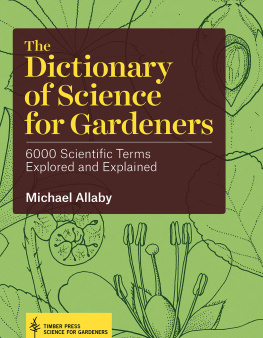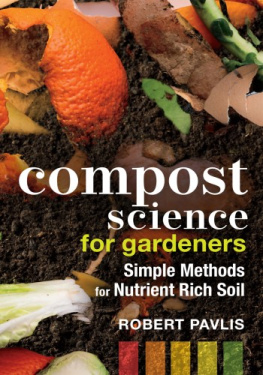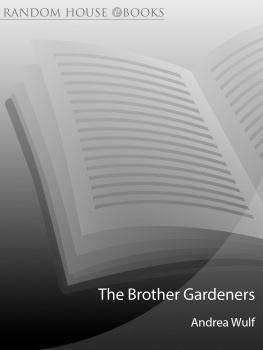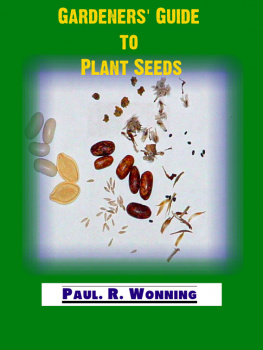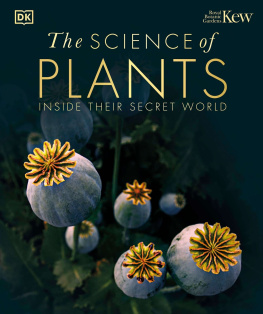The Dictionary of Science for Gardeners
6000 Scientific Terms Explored and Explained
Michael Allaby
TIMBER PRESS
Portland, Oregon
Copyright 2015 by Michael Allaby. All rights reserved.
Published in 2015 by Timber Press, Inc.
The Haseltine Building
133 S.W. Second Avenue, Suite 450
Portland, Oregon 97204-3527
timberpress.com
Text design by Patrick Barber
Cover design by Anna Eshelman
Library of Congress Cataloging-in-Publication Data
Allaby, Michael, author.
The dictionary of science for gardeners : 6000 scientific terms explored and explained / Michael Allaby. -- First edition.
pages cm
Includes bibliographical references and index.
ISBN 978-1-60469-483-3
1. Science--Dictionaries. 2. Gardening--Dictionaries. I. Title.
Q123.A498 2015
503--dc23
2015006909
A catalog record for this book is also available from the British Library.
Contents
Introduction
A garden is a place of delight. Conceived in the imagination of the gardener and realised through hours of toil in rain and shine, its produce feeds the body and its shapes, colours, and structures feed the soul. It is a paradise in miniature.
It is also a haven for wildlife. Flower petals are coloured, after all, in order to attract pollinating insects. And where there are insects there will be animals that feed on insects, and on surplus seeds, and on each other. The well-tended soil that garden plants require teems with living organisms, a world of its own inhabited by beings, most too small to be visible, that feed on detritus, and the terrifying monsters that hunt them.
The modern garden has evolved, at least in part, from gardens that were not intentionally ornamental. Monastic gardens grew plants with medicinal properties and these became physic gardens, and the gardeners were often apothecaries, the ancestors of our pharmacists. The Chelsea Flower Show is held in what was once known as the Apothecaries Garden. It was where trainee apothecaries learned their botany. Physicians, administers of physic, were also trained in botany. Carolus Linnaeus, perhaps the worlds most famous botanist, was a physician with a highly successful practice in Stockholm that gave him the time and money to further his studies of plants. He followed Olof Rudbeck (Rudbeckia bears his name) as director of the Botanic Garden at the University of Uppsala, which he rearranged and where he developed the system of biological classification that we use to this day. His garden is still there, and open to visitors. Botanic gardens exist, and have always existed, for purposes of scientific research and education, and nowadays for plant conservation. The fact that members of the public enjoy them is a bonus.
Gardens, then, are real. But not so many decades ago many scientists thought the modern private garden wholly artificial, merely a contrived collection of cultivated varieties of plants that had been selectively bred purely for their appearance, resistance to disease, and ability to thrive locally. Garden plants were far removed genetically from their wild ancestors, the proper plants. A garden was aesthetically pleasing perhaps, but it was of no botanical or ecological interest. Scientists conducted their fieldwork in ancient woodlands, natural grasslands, and alpine meadows, and scorned orchards, plantations, lawns, and rockeries.
Gardeners, of course, were not in the least troubled by this and probably were unaware of it. They gardened for pleasure and their skills were entirely practical. It was enough to know that a particular place was a frost hollow without knowing why it was, no knowledge of biogeography was needed to understand which plants were hardy and which were not, and gardeners knew the invertebrate animals that would attack their plants and the best ways of dealing with them. Seed catalogues and garden centres labelled plants with names that were familiar and no one but a specialist needed to know about the evolutionary relatives of any particular plant, or even how it came by its name.
Scientists began to take gardens more seriously when ecologists became concerned about the threats to wildlife that arose mainly from the intensification of arable farming. Meadows, a riot of flowers in summer, were being ploughed up and sown to much more productive temporary pastures containing a small number of grass species, where wild flowers were regarded as weeds. Hedges were being grubbed out to make larger fields more suited to modern farm machines, fields where combine harvesters could work three or more abreast. Everywhere, it seemed, natural habitats were disappearing or, more commonly, being degraded.
That was when scientists realised that ordinary gardens are not isolated entities. They offer privacy to their owners, and may be enclosed by hedges or fences, but far from being barriers to small animals, hedges provide cover, fences are perches and singing posts, and both can be tunnelled beneath or flown over. What is more, the gardens are adjacent to each other on either side of these imaginary boundaries, together occupying truly vast areas in urban settings. Scientists also noted that these entirely artificial gardens provide food and nesting sites to a wide range of species, including those being driven from farmland. Gardens are viable ecosystems growing many different plants, exotic it is true but edible to wildlife nonetheless, and they are already contributing to the conservation of species. Buddleja, native to tropical and warm climes and entirely alien to northern gardens, is now known as the butterfly bush. Clearly, gardens had to be taken seriously.
Excellent conservation areas though they are, gardens could be improved ecologically and gardeners soon found themselves being exhorted to provide small areas of enhanced habitat to attract hedgehogs, for example, and other small animals. They were advised about the preferred food plants for caterpillars, how to extend the growing season for flowers that supplied pollen for bees and other insects, and the desirability of wet areas and ponds to attract frogs and newts. They were warned not to provide so many nesting boxes that the surrounding area would provide too little food for the birds using them, so the young would starve. In TV programmes and magazine articles, gardeners were urged not to buy peat-based composts and soil conditioners because the industrial-scale mining of peat was destroying valuable habitat.
All of this advice and information drew on the findings of years of scientific research. Increasingly, and whether they were aware of it or not, gardeners were being invited to modify their methods and objectives, to introduce elements of applied science. Gardening books and magazines began to include scientific information. The material was treated lightly, but it encouraged readers to penetrate to the real science behind the simplification. Gardeners were being exposed to scientific writing. This is a trend that is likely to continue and accelerate, and as it does so amateur gardeners will encounter more and more scientific terms.
Many of these terms are likely to be unfamiliar, possibly intimidating, and some are misleading because they also have an everyday meaning that is subtly different. So what do you do when confronted with a strange vocabulary? You reach for a dictionary. The problem is that until now there has been no appropriate up-to-date dictionary of a convenient size available at an affordable price. This book aims to fill that gap.
How do you set about compiling a dictionary? I began by listing the branches of science gardeners might find relevant, and I found 16. They include plant classification, the science of how and why plants are grouped into genera and families, plant geography or how the world breaks down floristically, plant evolution, with the genetic code as an appendix, plant structure and function, or how plants work, fungi, insects, other invertebrate animals, vertebrate animals, bacteria and viruses, the way major nutrients move through cycles, pesticides, soil science including the way soils are classified, ecology, conservation, and weather and climate. I prioritized these, allotting a proportion of the dictionary to each, and then I commenced the writing and compilation.
Next page
